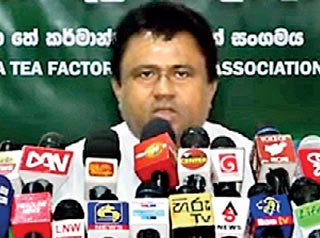Tuesday Apr 08, 2025
Tuesday Apr 08, 2025
Tuesday, 5 July 2022 03:34 - - {{hitsCtrl.values.hits}}
 |
| Sri Lanka Tea Factory Owner’s Association President Lionel Herath |
 |
| Sri Lanka Tea Factory Owner’s Association Joint Treasurer Dr. W. Jinadasa
|
Tea factory owners are fearing total closure owing to the worsening fuel crisis and other shocks putting much needed foreign exchange earnings at risk.
“There is a serious risk of all the tea factories in seven districts across the country coming to a standstill if sufficient fuel stocks are not received in the next few days. Right now, the factories are working three to four days per week as the rest of the days the employees are in fuel queues,” Sri Lanka Tea Factory Owner’s Association President Lionel Herath told journalists.
He claimed the Power and Energy Ministry’s support extended to one of the oldest and key export industries has been disappointing.
“Some tea factory owners have paid money to get fuel and built necessary storage tanks, but the fuel has not been provided till now.
Three months ago, our main issue was fertiliser, now it is the shortage of fuel to operate the factories,” he added.
It was pointed out that in the seven tea-growing districts, 264 private tea factories and another 258 factories under the plantation companies and non-members operating across the country are operating with utmost difficulties.
He also said the transportation of tea leaves has also been hampered due to fuel shortage and the wood prices have also increased significantly from Rs. 1,500 to Rs. 4,000.
“Tea factories have fallen into a serious crisis due to the power cuts, fuel shortage, economic crisis, and rising costs. The Government should pay more attention to the problems faced by the tea industry, which contributes significantly to the national economy,” Herath said.
As per him over 400,000 tea smallholders and nearly two million people or 10% of the total population are engaged in direct and indirect jobs related to the tea industry and are suffering from multiple issues.
Herath said they discussed with the Plantation Industries Minister to ensure a steady supply of fuel. SLTFOA Joint Treasurer Dr. W. Jinadasa said due to the shortage and price of fertiliser tea production and quality have dropped significantly.
“Tea production has dropped by 20% to 30% due to fertiliser, whilst the tea buds quality (two leaves and a bud) have dropped by 60% - 70%. There is a good price for tea in the market, but the industry does not have sufficient quality quantities due to short-sighted policies the Government implemented and the cost across the board has increased by three to four folds,” he added.
He also pointed out that the use of fertiliser has dropped by 80%, given the high prices at present.
“Previously, the tea fertiliser mixture was given at a concessionary price of Rs. 1,500, but following the organic fertiliser policy failure coupled with the exchange rate hike, a 50 kg fertiliser bag is now sold including extra Rs. 8,000. The high fertiliser prices cannot be absorbed by many producers at present, and it has impacted the quality tea leaves production,” he explained.
As entrepreneurs of the tea industry, Dr. Jinadasa said the sector has contributed significantly to the gross domestic product and earned much-needed foreign exchange — a key concern for the current economic crisis and shortage of reserves.
“We are sleeping on a treasure trove. Tea industry can easily earn around $ 5 billion. We can grow tea all year round, unlike most competitive countries, but our politicians and officials responsible have not introduced policies to develop the tea industry.”
He said the tea smallholders contribute around 75% of the 300 million kilograms of annual production, but the authorities have not given the due recognition and necessary support to develop the stakeholders.
“No one wants to develop local resources, otherwise there are many areas the authorities can develop. In 1990 Sri Lanka’s tea production was 11% of the GDP and it has dropped to 4% of the GDP in 2021. If the authorities understood the value of the sector in terms of foreign exchange generation, employment creation, poverty alleviation, and sustainable growth — our productions could have been over 20% of the GDP,” Dr. Jinadasa stressed.
It was pointed out that the best tea production era was from 1985 - 2005, and thereafter no significant initiatives were taken to replant and increase production countrywide.
Discover Kapruka, the leading online shopping platform in Sri Lanka, where you can conveniently send Gifts and Flowers to your loved ones for any event including Valentine ’s Day. Explore a wide range of popular Shopping Categories on Kapruka, including Toys, Groceries, Electronics, Birthday Cakes, Fruits, Chocolates, Flower Bouquets, Clothing, Watches, Lingerie, Gift Sets and Jewellery. Also if you’re interested in selling with Kapruka, Partner Central by Kapruka is the best solution to start with. Moreover, through Kapruka Global Shop, you can also enjoy the convenience of purchasing products from renowned platforms like Amazon and eBay and have them delivered to Sri Lanka.
Discover Kapruka, the leading online shopping platform in Sri Lanka, where you can conveniently send Gifts and Flowers to your loved ones for any event including Valentine ’s Day. Explore a wide range of popular Shopping Categories on Kapruka, including Toys, Groceries, Electronics, Birthday Cakes, Fruits, Chocolates, Flower Bouquets, Clothing, Watches, Lingerie, Gift Sets and Jewellery. Also if you’re interested in selling with Kapruka, Partner Central by Kapruka is the best solution to start with. Moreover, through Kapruka Global Shop, you can also enjoy the convenience of purchasing products from renowned platforms like Amazon and eBay and have them delivered to Sri Lanka.